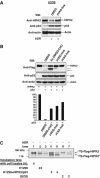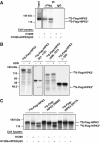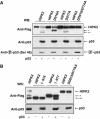Autoregulatory control of the p53 response by caspase-mediated processing of HIPK2
- PMID: 16601678
- PMCID: PMC1456935
- DOI: 10.1038/sj.emboj.7601077
Autoregulatory control of the p53 response by caspase-mediated processing of HIPK2
Abstract
The serine/threonine kinase HIPK2 phosphorylates the p53 protein at Ser 46, thus promoting p53-dependent gene expression and subsequent apoptosis. Here, we show that DNA damaging chemotherapeutic drugs cause degradation of endogenous HIPK2 dependent on the presence of a functional p53 protein. Early induced p53 allows caspase-mediated cleavage of HIPK2 following aspartic acids 916 and 977. The resulting C-terminally truncated HIPK2 forms show an enhanced induction of the p53 response and cell death, thus allowing the rapid amplification of the p53-dependent apoptotic program during the initiation phase of apoptosis by a regulatory feed-forward loop. The active HIPK2 fragments are further degraded during the execution and termination phase of apoptosis, thus ensuring the occurrence of HIPK2 signaling only during the early phases of apoptosis induction.
Figures








References
-
- Brummelkamp TR, Bernards R, Agami R (2002) A system for stable expression of short interfering RNAs in mammalian cells. Science 296: 550–553 - PubMed
-
- D'Orazi G, Cecchinelli B, Bruno T, Manni I, Higashimoto Y, Saito S, Gostissa M, Coen S, Marchetti A, Del Sal G, Piaggio G, Fanciulli M, Appella E, Soddu S (2002) Homeodomain-interacting protein kinase-2 phosphorylates p53 at Ser 46 and mediates apoptosis. Nat Cell Biol 4: 11–19 - PubMed
-
- de Souza PM, Kankaanranta H, Michael A, Barnes PJ, Giembycz MA, Lindsay MA (2002) Caspase-catalyzed cleavage and activation of Mst1 correlates with eosinophil but not neutrophil apoptosis. Blood 99: 3432–3438 - PubMed
Publication types
MeSH terms
Substances
LinkOut - more resources
Full Text Sources
Molecular Biology Databases
Research Materials
Miscellaneous

